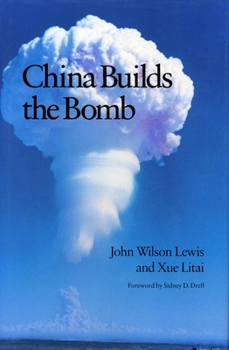China Builds the Bomb
Select Format
Select Condition 
Book Overview
A Stanford University Press classic.
Format:Paperback
Language:English
ISBN:0804718415
ISBN13:9780804718417
Release Date:April 1991
Publisher:Stanford University Press
Length:352 Pages
Weight:1.15 lbs.
Dimensions:1.0" x 6.0" x 9.0"
Related Subjects
Engineering History Military Science Military Sciences Science & Math Social Sciences TechnologyCustomer Reviews
3 ratings
How The Chinese Entered The Nuclear Club
Published by Thriftbooks.com User , 16 years ago
I read this book for a graduate history class on Mao's China The authors John Wilson Lewis, and Xue Litai astutely argued that Mao's decision to acquire nuclear weapons was both a response to what he perceived as repeated nuclear threats from the U.S., particularly during the Korean War and the Taiwan Straits Crisis of the 1950's. Mao also insisted that a nuclear weapon would prove China's military prowess, which would distinguish the "New China" from its humiliated previous governments. The book expertly describes each stage of the nuclear weapons program--mining, processing, and enrichment of uranium and the designing, constructing and assembling, and testing of their first device. The book also delves into the political process including Sino-Soviet relations from 1953 to 1967. The authors used printed sources from China and the U. S. the memoirs of Nie Rongzhen, the father of China's nuclear program, as well as extensive interviews of both Chinese scientists and policy makers. By 1953 the Chinese, under the guise of peaceful uses of nuclear energy, had initiated research leading to the development of nuclear weapons. The decision to develop an independent strategic nuclear force was made no later than early 1956 and was to be implemented within the Twelve-Year Science Plan presented in September 1956 to the Eighth Congress of the CCP. The decision to enter into a development program designed to produce nuclear weapons and ballistic missile delivery systems was, in large part, a function of the 1953 technology transfer agreements initiated with the USSR. 14 February 1950 China and the Soviet Union sign the "Sino-Soviet Treaty of Friendship, Alliance and mutual Assistance." 1955 Peking signed a secret agreement with Moscow through which China provided uranium ores in exchange for Soviet assistance in the nuclear field (7, 41, 76). China was politically motivated to develop nuclear weapons following the events of the Korean War, French Indochina War, and Taiwan Strait Crisis. During this time, China's military was still largely technologically undeveloped and was receiving large amounts of assistance from the Soviet Union since the early 1950s. Soviet nuclear aid was given to China, and several eastern European nations, under the pretext that it would be used for peaceful purposes. In mid-October 1957, the Chinese and Soviets signed an agreement on new technology for national defense that included provision for additional Soviet nuclear assistance as well as the furnishing of some surface-to-surface and surface-to-air missiles. The USSR also agreed to supply a sample atomic bomb and to provide technical assistance in the manufacture of nuclear weapons. Of the assistance provided, most significant to China's future strategic nuclear capability were an experimental nuclear reactor, facilities for processing uranium, a cyclotron, and some equipment for a gaseous diffusions plant (41-46, 76-86, 90-91, 105-106, 118). 20 June 1959 T
Chinese Bomb - Chairman Mao's basic believe.
Published by Thriftbooks.com User , 21 years ago
Lest when my review is read, readers will think I'm sympathetic to Chinese socialism. The fact is I am not. I have read the book - China Builds The Bomb - some years ago. This book must be read in the perspective of China's recent history. In the Chinese world of the l960's, internally, China was beset with how to feed her people due to a series of natural calamities and externally, how to defend itself from its neighbour - the unfriendly Soviet Union as well as hostility from United States.China's intention to build the bomb was basically for self-defense and not to threaten others nor for sable-rattling. I think China had achieved its aim of protecting itself. China's knowledge in building the bomb was based mainly on her core of scientific people, public sacrifices and native innovations. Chinese people realized long ago that the defense of their nation depended on the resolve and determination of themselves. The fact that against seemingly insurmountable odds, both technical and scientific, the Chinese people could build first the atomic bomb and then the hydrogen bomb, prove beyond a shadow of doubt of the saying: "Necessity is the mother of invention." Since then, I have read this acclaimed book several time, and each time when I read it, I couldn't help thinking that my ancestral country - China - despite being bullied and invaded the last 50 years by foreign powers, the people are resolved never to be weak again in the predatory world of today! Thank you.
China's insecurity/ Mao's paper tiger !!
Published by Thriftbooks.com User , 23 years ago
A rich and facinating account of how China made the decision to build the bomb. The origins of the Chinese nuclear program were made during the Eisenhower administration desion to reduce American troops in Korea. During this period, Eisenhower decided to increase American strategic forces (nuclear), thus adding to Chinese insecurity. According to the book, Mao wanted a paper tiger and the nuclear bomb was the answer. The book also details how Soviet advisors provided the Chinese with baseline technical information for theroretical experimentation and fabrication of the first bomb. The book makes clear that the Sino-Soviet alliance was a shakey mutual military agreement at best. Moscow wanted total control of Soviet/Chinese military operations and how Chinese military leaders resisted these attempts by Moscow and decided to expel Soviet advisors. The book also explains how the CIA blew the call: They predicated a pultonium core and in fact the Chinese built a uranium-235 core.A must for anyone interested in understanding American/Chinese Foreign policy in present day Chinese-Amercian relations






